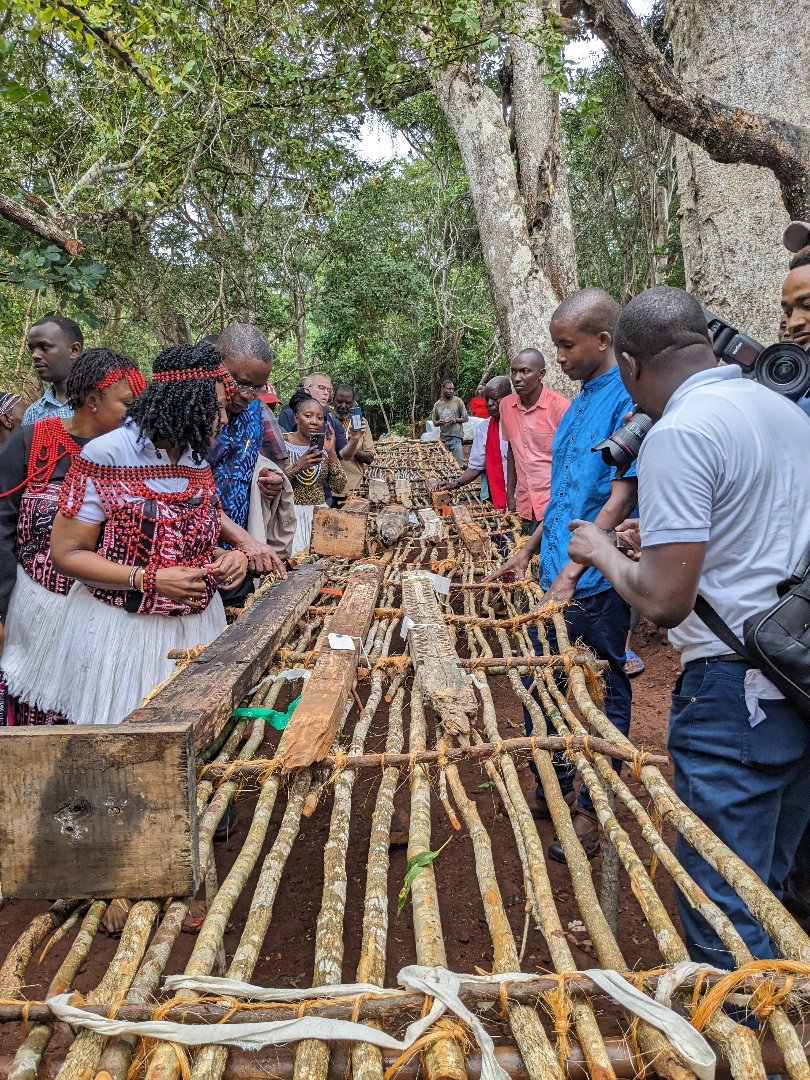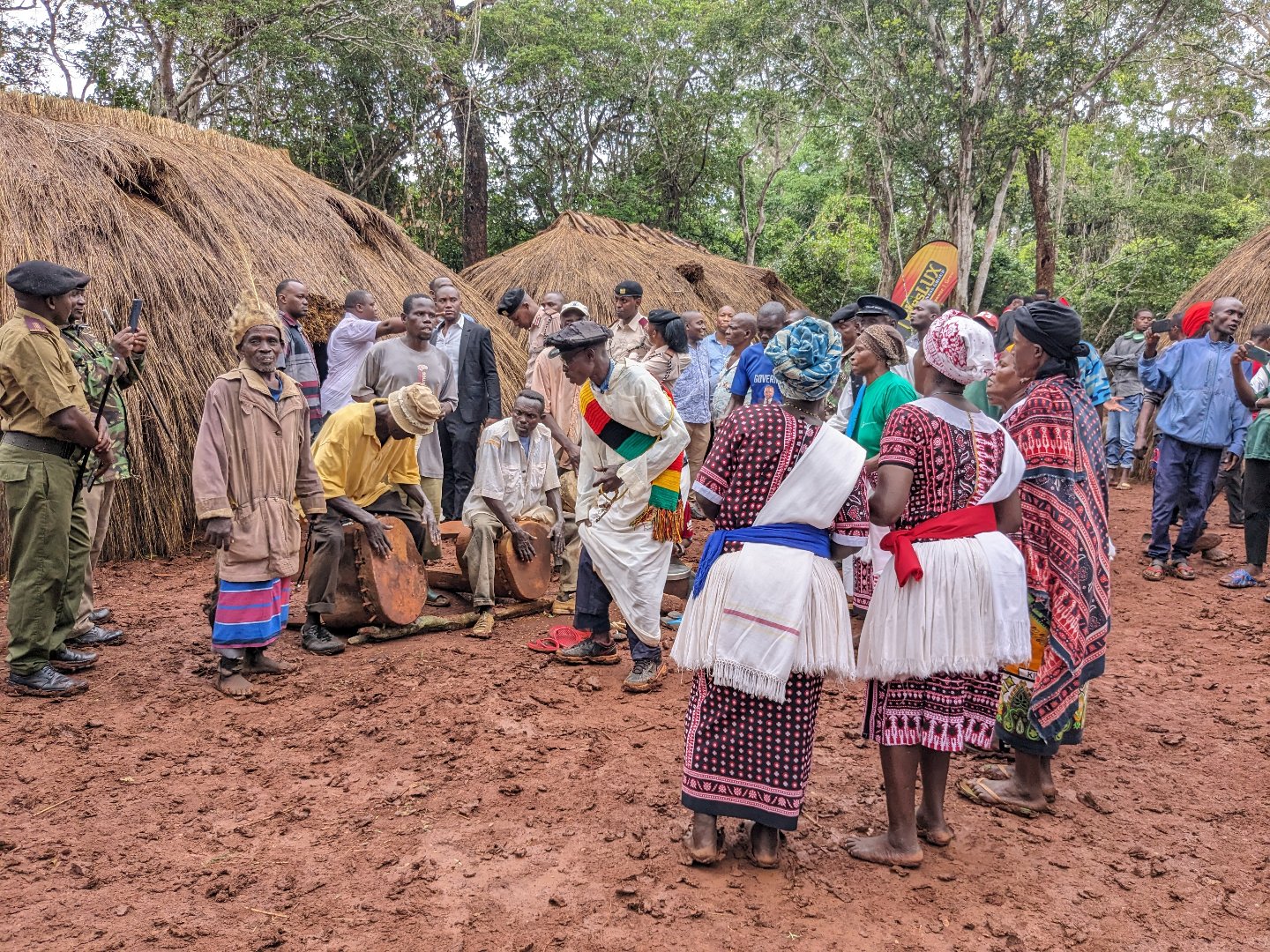Bringing the Ancestors Home
This July, Newfields was honored and privileged to participate in a once-in-a-lifetime ceremony deep in the Kilifi Forest in Eastern Kenya. The local Mijikenda community, our hosts, invited us to celebrate the homecoming of 55 vigango memorial statues that had been housed in two American museums, including Newfields, for over forty years. Our journey to this sacred forest began two years prior and took a collaboration of global proportions to see that celebratory moment come to fruition.
Mijikenda elders performing the ceremonial return of ancestors in the Kaya Kauma forest in Kenya.
I first learned about the Mijikenda people in May of 2021 while listening to a webinar that discussed the endemic theft of vigango from their sacred forests, and how two museums—the Denver Museum of Nature and Science and the National Museums of Kenya—worked together to repatriate 30 vigango two years prior. Their story was moving, as they described the impact these thefts had on the community and the lack of action taken by museums with these objects in their collections. I immediately recognized the objects being discussed in this Zoom presentation—four were on view in our African gallery, and a further 14 in art storage. As the Manager of Curatorial Affairs, two of my primary responsibilities are to care for our collections that do not have curatorial representation on staff and to shepherd special projects. The Indianapolis Museum of Art does not currently have an African Art curator, so when I learned about the Mijikenda and the vigango within our museum my two duties combined and a project unfurled.
The Mijikenda are nine tribal communities spread along coastal Kenya. Their spiritual belief system involves a hierarchy of elders that provide guidance and tribal governance. When an elder passes away, another elder waits for the deceased to appear to him in a dream, which is the sign that they have transitioned to the spiritual realm. After the dream, the living elder harvests a piece of wood in the community’s sacred forest, called a kaya, and carves a kigango post to represent the deceased elder. Each kigango (singular form of vigango) is uniquely carved and adorned. After the elders perform a secret and sacred ceremony the soul of the deceased enters the kigango, which becomes the physical embodiment of the elder. Vigango are erected in the kaya so that they can be visited by family and community members seeking comfort, advice, or prayer—very similar to how ancestors are visited in cemeteries in many faith practices. Vigango are of critical importance to the Mijikenda, as the deceased elders can continue sharing their knowledge with their community while in the form of a kigango. Once a kigango naturally decomposes it is a sign that the elder has completed the sharing of their knowledge and their soul has moved on from this realm.
In the 1970s, the art market exploded with interest in collecting art from Africa. To feed the growing desire for such objects the black market surged, resulting in untold levels of looted African patrimony entering galleries and museums. The Mijikenda were victims of these crimes, often finding their ancestors stolen overnight from their resting place in the kaya. Theft of vigango creates a tear within the fabric of their spiritual beliefs. Not only has their ancestor’s soul been abducted, but interrupting the process of natural decomposition of the kigango traps the ancestor, preventing them from completing their purpose and time on Earth. Vigango began appearing in museums in Europe and the United States accompanied by the false narrative that the Mijikenda no longer wanted these objects and their spiritual usefulness had been fulfilled. Over the ensuing decades, the Mijikenda have tried desperately to see the return of their ancestors, but with few resources to counter this falsehood and little in terms of global support for sharing their story, their plight has gone largely unfollowed.
Upon learning of the illegal removal of vigango from kayas, I created a cross-departmental team that worked collaboratively to pursue repatriation—the ethical return of these 18 ancestors to their community and rightful owner. A critical step when pursuing repatriation is building trust with the parties involved. We established a strong relationship with the National Museums of Kenya, who the Mijikenda identified as their partner for the repatriation of the ancestors, and the conduit for communicating with the tribal representatives. In August 2021, we were able to speak directly with Mijikenda elders in Kenya through a Zoom call. We stated our commitment to their cause and shared images of the vigango housed in Indianapolis. Afterwards, they gave us a blessing and said, “Bring our ancestors home.”

Mijikenda people welcoming vigango home before the ceremonial return.
One of the most intricate aspects of repatriation is the physical return of the objects. Given that shipping and customs clearance is a fraught process, our precious shipment of 18 ancestors required untold levels of diligence and detail managed with aplomb by Jennifer Rigsby, Registrar for the Permanent Collection. Our shipment of vigango arrived in Nairobi, without incident, and into the hands of the National Museums of Kenya on October 27, 2022. Newfields became the third museum to have successfully returned vigango. The ancestors were almost home.

Celebration continues with music, dancing, and speeches.
Nine months later, on July 12, 2023, I entered the Kaya Kauma with my colleagues, Dr. Colette Pierce Burnette, President and CEO, and Monica Richardson, Chief of Staff. We were invited to participate in a joint ceremonial return with the Illinois State Museum, which had recently returned 37 vigango. The ancestors were brought into the forest, cleansed, and welcomed home. The atmosphere was celebratory, and we were greeted with music, dancing, and open arms from 250 guests, dignitaries, and elected officials. Dr. Burnette gave a speech to the gathered crowd in which she spoke of the importance of being home amongst one’s community. While we were in the kaya it began to rain, which the Mijikenda celebrated as a good omen indicating that the ancestors were finally at rest.
Dr. Burnette addressing the importance of being home in her speech.
Today, at the request of the Mijikenda, the 85 returned vigango from Denver, Illinois, and the Indianapolis Museum of Art, are safely housed in Mombasa at the National Museums of Kenya’s site in Fort Jesus. They cannot be replanted in the kayas for fear that they will be stolen again. The Mijikenda, with support from museums, are discussing a more permanent housing solution for returned vigango, such as building a community center. It is estimated that over 400 vigango remain in American museums, with an untold number in private collections. Vigango are still sold on the black market and auction websites, perpetuating the illegitimate claim that they are no longer sacred nor wanted by their community.
We left the ceremony in July with a directive from the Mijikenda: share this story, share what we saw in the kaya. By recognizing what has happened to this community each of us has the opportunity to promote awareness of the Mijikenda and help bring their ancestors home.
Image Credit:
All images shared with approval of the Mijikenda community.
Installation view of four vigango formerly installed in the Eiteljorg Suite of African Art gallery.




